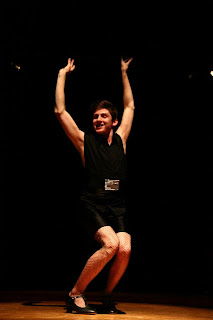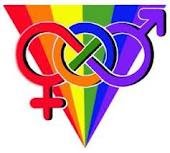Given the high-tension, ever-changing complex of interpersonal psycho-sexual dynamics in high schools, what role can teachers and administrators play in steering them in a positive direction? How is that PCVS has managed to evolve a culture in which the problematic dynamics described in the previous two posts are minimized?
At some point, a group of staff members made a commitment to start work on creating a safe space for everyone, including those expressing same-sex desire or questioning their gender identities. It couldn’t have been easy. A group effort was required, and fortitude to stay the course. But with the progressive effects of two generations of feminism to work with, these staff must have had hope that they could succeed.
Today, key PCVS teachers continue to make it their business to promote acceptance of diversity in sexuality, encourage an open expression of identity, and prevent the kinds of personal problems that lead students to bullying. And a generation of children of progressively-minded parents has gotten on board.
But what about other schools?
Imagine you’re a new principal at a KPR high school, advanced to the position after only a few years in the classroom. You’re an effective manager, but not an experienced psychologist. The culture of your school isn’t particularly progressive. You get reports of girls being cyber-bullied, confirmed by absenteeism records. You hear stories of male students getting beat up after school. You suspect sexuality is involved, but what do you do, beset with moral and managerial expectations from all sides?
KPR is promoting an anti-bullying campaign – but that doesn’t help you deal with the roots of the problems. Unless it’s a sex education class, you ask yourself, is it even okay for teachers and principals to be talking about sexuality with students – even students of the same gender?
If you have any staff involved in same-sex relationships, they’re hiding it well. It has long been acceptable for female teachers to remain unmarried, and to spend their lives in the company of other women – but unmarried men will often be suspected of homosexuality, and distrusted. Are you supposed to go prying into their personal lives? What if they take it the wrong way?
You know that most parents are frightened of discussing heterosexuality with their kids, let alone homosexuality. And they’re frightened of what their kids might be doing or even just talking about doing at school. Some families belong to religious groups which follow very strict doctrines regarding sexuality, and prohibit homosexuality entirely.
Some students decide to form a “Gay-Straight Alliance Ontario
Eventually you realize that the GSA depends on the precarious initiative of a few brave students on both sides, mainly females. Why? As discussed in the previous post, the stakes are lower for girls when it comes to supporting same-sex love than they are for guys, and there are some circumstances which produce girls who are mature thinkers with secure psychologies who won’t be fazed by the treacherous territory they enter with GSAs. When the alliance between a group of heterosexual girls, their lesbian counterparts, and their gay male friends ends with graduation, can you be sure that the younger generations will take up the torch?
Then you think about PCVS. You know its reputation, but since you barely have time to think about anything but your own school, you figure the progressive culture they’re reputed to have is just because of the Arts program. You need more information, so you look up some recent posts on PCVS Cornerstone in hopes of gaining some insight.
After reading the posts, you ask yourself an important question: how can you expect heterosexual guys to get involved with a club with the word “gay” in the name?
Administrators across the province, instead of debating whether “Gay-Straight Alliances” should be allowed, should be asking how it is that we’ve come to rely on a euphemism referring to the flamboyant style of some homosexual men to refer to same-sex love of all types.
Isn’t continuing to use the term “gay” as a catch-all for homosexual and bisexual males and females misleading and simplistic? Would girls be as keen to join up if the clubs were called “Dyke-Straight Alliances?” How is using slang terms like “gay” and “straight” in a formal context any more appropriate than if we were to have a “Brainers Club” for enrichment programming, “Shrink Sessions” for students needing counselling, or put a sign with the words “Jock Department” up on the Phys. Ed. teacher’s door? Why is it inconceivable that we could have a club with the word “sex” or “sexuality” in the name at the high school level?
McGuinty’s Liberal caucus may be able to get their anti-bullying legislation passed easily. But how easy is it going to be to use these laws to deal with any of the core issues addressed in these recent posts? Practically impossible.
On the other hand, what could Queen’s Park accomplish by refusing to let KPR’s administrators shut down PCVS, the greatest asset they have in the battle against bigotry and bullying?
Plenty.
And what would they lose by failing to act? Nothing more than Central Ontario ’s leading light in the campaign against bullying.
There needs to be a basic culture change in high schools, and it needs to start at the top. And it can’t be always women who are doing the work. In fact, the people who most need to step up are heterosexual men.
The people with the most to lose socially by supporting same-sex love are young heterosexual men. From their point of view, they open themselves to the same kinds of abuse that homosexual males receive just by being associated with them in any way. They will risk significant loss of social status, and what would they stand to gain in return? Virtually nothing.
Nothing – except a school environment that is less judgmental, less splintered, and less competitive. Nothing except a place in which signficant numbers of students aren’t spending all their energy pretending to be someone other than themselves. Nothing except a prototype for a society that recognizes that we all have more in common than not. Nothing except more friends, and fewer cliques. Nothing except reduced levels of fear and anxiety for everyone. Nothing except a generation of males who aren’t afraid to confront the wide potential spectrum of their own sexual desire.
Maybe it’s not such a bad gamble after all. But who’s going to be the first to take it?
Should it not be the Director of Education himself?
Does the current Director of Education for KPR have the fortitude to step up, speak up, and reverse the decision to close PCVS? Does he realize that he has the opportunity as a heterosexual male to set the tone for everyone else by acknowledging PCVS as his board’s greatest ally in the campaign to eliminate bullying and open the way to individual and community success?
PCVS isn’t just a building, an institution, a history, or a launching pad for post-secondary education or a job. And it’s more than just a haven for young people who have been bullied elsewhere. It’s an evolving micro-society working toward creating the kind of macro-society to which our greatest humanist aspirations, our charter of rights, and our deepest psychological needs are leading us.
PCVS is a living work-in-progress of the kind of society that might be achieved with a concerted effort to transform natural adolescent competitiveness and insecurity into an embrace of diversity, laying the foundation of our collective response to the challenges posed by a future in which difference is no longer the exception to the rule, but the rule itself.














